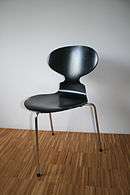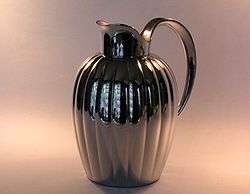Danish design

Danish Design is a style of functionalistic design and architecture that was developed in mid-20th century. Influenced by the German Bauhaus school, many Danish designers used the new industrial technologies, combined with ideas of simplicity and functionalism to design buildings, furniture and household objects, many of which have become iconic and are still in use and production. Prominent examples are the Egg chair, the PH lamps and the Sydney Opera House (Australia).
Designers
Among the most successful designers associated with the concept are Børge Mogensen (1914–72), Finn Juhl (1912–89), Hans Wegner (1914–2007), Arne Jacobsen (1902–71), Poul Kjærholm (1929–80), Poul Henningsen (1894–1967) and Verner Panton (1926–98).[1]
Other designers of note include Kristian Solmer Vedel (1923–2003) in the area of industrial design, Jens Harald Quistgaard (1919–2008) for kitchen furniture and implements, Gertrud Vasegaard (1913–2007) for ceramics, and Ole Wanscher (1903–85), who had a classical approach to furniture design.
History

The Danish Culture Canon credits Thorvald Bindesbøll (1846–1908) with early contributions to design in the areas of ceramics, jewellery, bookbinding, silver and furniture although he is known in the rest of the world for creating the Carlsberg logo (1904), still in use today.[2] The Canon also includes Knud V. Engelhardt (1882–1931) for a more industrial approach, especially in the rounded contours of his electric tramcar designs which were widely copied.[3] In the area of textiles, Marie Gudme Leth (1895–1997) brought the screen printing process to Denmark, opening a factory in 1935 which allowed her colourful patterns to be manufactured on an industrial basis.[4] August Sandgren introduced functionalism in the design of his masterful bookbindings.
In the late 1940s, shortly after the end of the Second World War, conditions in Denmark were ideally suited to success in design. The emphasis was on furniture but architecture, silver, ceramics, glass and textiles also benefitted from the trend. Denmark's late industrialisation combined with a tradition of high-quality craftsmanship formed the basis of gradual progress towards industrial production. After the end of the war, Europeans were keen to find novel approaches such as the light wood furniture from Denmark. Last but not least, support in Denmark for freedom of individual expression assisted the cause.[5]
The newly established Furniture School at the Royal Danish Academy of Art played a considerable part in the development of furniture design. Kaare Klint taught functionalism based on the size and proportions of objects, wielding considerable influence. Hans J. Wegner, who had been trained as a cabinetmaker, contributed with a unique sense of form, especially in designing chairs.[6]
As head of the cooperative FDB furniture design studio, Børge Mogensen designed simple and robust objects of furniture for the average Danish family. Finn Juhl demonstrated an individualistic approach in designing chairs with an appealing but functional look.
In the early 1950s, American design also influenced Danish furniture. The American Charles Eames designed and manufactured chairs of moulded wood and steel pipes. These encouraged Arne Jacobsen to design his worldfamous Ant Chair, Denmark's first industrially manufactured chair. Furthermore, as Shaker furniture—and especially its reputation for stripped down chairs—began to be more and more known abroad, it also influenced Danish designers.[7]
Poul Kjærholm, Verner Panton and Nanna Ditzel followed a few years later, continuing the successful story of Danish design. Kjærholm worked mainly in steel and leather, Panton left Denmark during the 1960s to continue designing imaginative but highly unconventional plastic chairs while Nanna Ditzel, who also had a strongly individualistic approach, was successful in helping to renew Danish furniture design in the 1980s.
Modern trends

Danish furniture design failed to make any new important contributions in the 1970s and 1980s. By contrast, industrial designers began to prosper, making use of the basic principles of focus on the user, respect for materials and attention to detail. For example, there are well known Danish designers, like Tobias Jacobsen (the grandson of Arne Jacobsen), who focused on the single elements of a violin when creating his chair "Vio" or on a boomerang when designing his eponymous sideboard.[8]
The Bernadotte & Bjørn studio, established in 1950, was the first to specialise in industrial design, with an emphasis on office machines, domestic appliances and functional articles such as the thermos jug. The electronics manufacturer Bang & Olufsen, in collaboration with Bernadotte & Bjørn and later with Jacob Jensen and David Lewis, went on to excel in modern design work. Around the same time, the Stelton company collaborated with Arne Jacobsen and Erik Magnussen to produce their iconic vacuum jug, a huge international success.
Another successful design field is medical technology. Danish design companies like 3PART, Designit and CBD have worked in this area with individual designers such as Steve McGugan and Anders Smith.
In 2002 the Danish Government and the City of Copenhagen launched an effort to establish a world event for design in Copenhagen. Originally understood as a tool for branding traditional Danish design, the non-profit organization INDEX: shifted focus after worldwide research and coined the concept of Design to Improve Life, which rapidly became celebrated in Denmark and around the world. The organization now hands out the biggest design award in the world biannual in Copenhagen, tours large scale outdoor exhibition around the world, run educational program as well as design labs and hosts a global network.
Today, there is strong focus on design in Denmark as industry increasingly appreciates the importance of design in the business environment. In addition, as part of its trade and industry policy, the Danish government has launched the DesignDenmark initiative which aims to restore Denmark to the international design elite.[9]
Architecture

Modern architecture has also contributed to the concept of Danish design.
Arne Jacobsen was not just a furniture designer but one of the leading architects of his times. Among his achievements are the Bellevue Theater and restaurant, Klampenborg (1936), the Århus City Hall (with Erik Møller; 1939–42) and the SAS Royal Hotel (1958–60).[10]
Jørn Utzon (1918–2008), Denmark's most widely recognized architect, is remembered for his expressionist Sydney Opera House (1966) and the later Bagsværd Church (1976) with its wavy concrete roof.[11]
Henning Larsen (b. 1925) is the architect who designed the boldly modern Copenhagen Opera House on the island of Holmen which was completed in 2005.[12]
Recent achievements
Today, the concept of Danish design is thriving in an ever wider number of fields. Among recent highlights are:
- The Museum of Modern Art in New York has chosen to outfit 95% of its new Yoshio Taniguchi-designed home with furniture by Danish design company GUBI.
- The Danish Zenvo ST1 supercar.[13][14]
- The Evita Peroni suite of women's accessories which now has some 300 stores in 30 countries.[15]
- The Halifax Central Library in Halifax, Nova Scotia, Canada, was designed by the Danish architectural firm Schmidt Hammer Lassen. After it was completed in 2014, it has received widespread acclaim[16][17] and several architecture awards.[18][19]
Museums
- The Danish Museum of Art & Design in Copenhagen exhibits many of the artifacts associated with Danish design, especially furniture.
- The New York Museum of Modern Art also has a large Danish design collection.[20]
- The Danish Design Centre in the centre of Copenhagen has both permanent and special exhibitions promoting Danish design.
See also
| Wikimedia Commons has media related to Design of Denmark. |
- BoConcept
- Carl Hansen & Søn
- Architecture of Denmark
- Danish modern
- Danish Culture Canon
- Anders Nørgaard
References
- ↑ "Danish Design and Architecture", About Denmark, Denmark, archived from the original on 20 May 2009, retrieved 17 December 2008
- ↑ Thorvald Bindesbølls livsværk (PDF) (in Danish), DK: Skoletjensten Kunstindustrimuseet, retrieved 24 January 2013.
- ↑ Knud V. Engelhardts livsværk (PDF) (in Danish), DK: Skoletjenesten Kunstindustrimuseet, retrieved 22 January 2013.
- ↑ "Marie Gudme Leth", Dansk Biografisk Leksikon (in Danish), DK: Den store danske, retrieved 23 January 2013.
- ↑ Furniture and Industrial Design (PDF), DK: Ministry of Foreign Affairs, retrieved 17 December 2008.
- ↑ "Designers", Danish Furniture, retrieved 17 December 2008.
- ↑ Taft, Maggie, "Morphologies and Genealogies; Shaker Furniture and Danish Design," Design and Culture 7:3, 313-334.
- ↑ Designerprofile Tobias Jacobsen, D: Fashion For Home, retrieved 2015-09-11.
- ↑ DesignDenmark (PDF), DK: The Danish Government, retrieved 17 December 2008.
- ↑ "Who is Who in Historical Danish architecture", About, DK: Denmark, archived from the original on 20 May 2009, retrieved 18 December 2008
- ↑ "Copenhagen: Bagsvaerd Kirke Utzon", e-architect.co.uk, UK, retrieved 18 December 2008
|contribution=ignored (help). - ↑ "Opera House", Copenhagen, UK: e-architect, retrieved 18 December 2008.
- ↑ "Zenvo to Produce "Real Supercar with Excessive Power"", Motor Trend, 17 December 2008,
The phrase “Danish design” brings to mind odd-looking chairs and bright-colored handbags — not (this supercar). Still, Zenvo Automotive asserts its ST1 hypercar is pure Dane conceived, engineered, and assembled.
. - ↑ Zenvo Automotive, retrieved 18 December 2008.
- ↑ SHH Create New Store Concept for Evita Peroni, Dexigner, retrieved 19 December 2008.
- ↑ "10 eye-popping new buildings that you'll see in 2014". CNN Style. CNN. Retrieved 6 May 2014.
- ↑ "Wired names Halifax's flagship library among top 10 most beautiful in the world". CBC News. 9 September 2016.
- ↑ Wall, Don (12 November 2015). "ACEC awards: SNC-Lavalin triumphs with Halifax library". Daily Commercial News.
- ↑ "Halifax Central Library nominated for prestigious architectural award". CBC News. 23 June 2015.
- ↑ Danish design at MoMA, House of Copenhagen, retrieved 18 December 2008.
External links
- Examples of Mid Century Modern Design, Architonic.
- Mid Century Modern Furniture, Decorative Objects, and Art, Formare vivo.
- Danish Design, NL: Alfems.
- Development Services in Lahore, NL: Alfems.